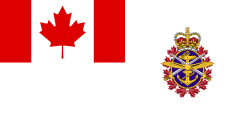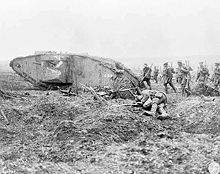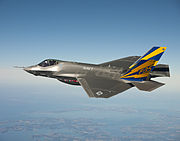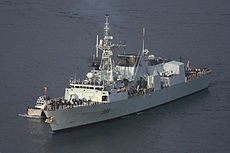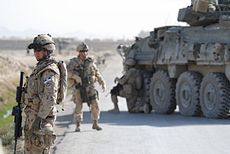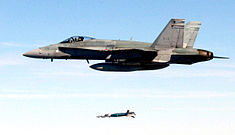- Canadian Forces
-
Canadian Armed Forces
Forces armées canadiennes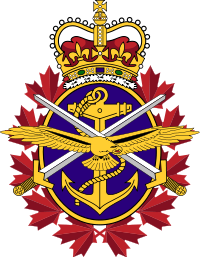
Emblem of the Canadian ForcesCurrent form 1968 Service branches  Royal Canadian Navy
Royal Canadian Navy
 Canadian Army
Canadian Army
 Royal Canadian Air Force
Royal Canadian Air ForceHeadquarters NDHQ, Ottawa Leadership Commander-in-Chief Elizabeth II, Queen of Canada, represented by Governor General David Lloyd Johnston Minister of National Defence Peter MacKay Chief of the Defence Staff[1] General Walter Natynczyk Manpower Military age 17–60 years old[N 1] Conscription No Available for
military service8,072,010 males, age 17–60[3],
7,813,462 females, age 17–60[3]Fit for
military service6,646,281 males, age 17–60[3],
6,417,924 females, age 17–60[3]Active personnel 68, 250 (31 March 11)[2] (ranked 56th) Reserve personnel 26,873 (paid primary)
4,635 (Rangers)
15, 573 (supplementary) (31 March 11)[2]Deployed personnel 950+ Expenditures Budget C$21.8 billion,[4] (2010–2011) (ranked 15th) Percent of GDP 1.14% (111th in world) Industry Domestic suppliers L-3 Communications MAS
CAE
Meggitt Training Systems Canada
General Dynamics
Irving Shipbuilding Inc.
General Dynamics Land Systems Canada
Raytheon Canada Limited
Seaspan Marine Corporation
Thales Canada
The Boeing Company[5]Related articles History Military history of Canada Ranks Canadian Forces ranks and insignia The Canadian Forces (CF) (French: Forces Canadiennes; FC), officially the Canadian Armed Forces (French: Forces armées canadiennes),[6] are the unified armed forces of Canada, as constituted by the National Defence Act, which states: "The Canadian Forces are the armed forces of Her Majesty raised by Canada and consist of one Service called the Canadian Armed Forces."[6] This single institution consists of the sea, land, and air environmental commands called the: Royal Canadian Navy (RCN), Canadian Army, and Royal Canadian Air Force (RCAF), which together are overseen by the Armed Forces Council, chaired by the Chief of the Defence Staff. At the pinnacle of the command structure is the Commander-in-Chief, who is the reigning Canadian monarch, Elizabeth II,[7] represented by the governor general.[8]
Contents
Defence policy
Canadian defence policy
Since the Second World War, Canadian defence policy has consistently stressed three overarching objectives:
- The defence of Canada itself;
- The defence of North America in cooperation with US forces;
- Contributing to broader international security.
During the Cold War, a principal focus of Canadian defence policy was contributing to the security of Europe in the face of the Soviet military threat. Toward that end, Canadian ground and air forces were based in Europe from the early 1950s until the early 1990s.
However, since the end of the Cold War, as the North Atlantic Treaty Organization (NATO) has moved much of its defence focus "out of area", the Canadian military has also become more deeply engaged in international security operations in various other parts of the world – most notably in Afghanistan since 2002.
Canadian defence policy today is based on the Canada First Defence Strategy,[9] introduced by the Conservative Government of Stephen Harper after he took office in 2006. Based on that strategy, the Canadian military is oriented and being equipped to carry out six core missions within Canada, in North America and globally. Specifically, the Forces are tasked with having the capacity to:
- Conduct daily domestic and continental operations, including in the Arctic and through NORAD (the North American Aerospace Defense Command);
- Support a major international event in Canada, such as the 2010 Winter Olympics;
- Respond to a major terrorist attack;
- Support civilian authorities during a crisis in Canada such as a natural disaster;
- Lead and/or conduct a major international operation for an extended period; and
- Deploy forces in response to crises elsewhere in the world for shorter periods.[10]
Consistent with the missions and priorities outlined above, the Canadian Forces also contribute to the conduct of Canadian defence diplomacy through a range of activities, including the deployment of Canadian Defence Attachés,[11] participation in bilateral and multilateral military forums (e.g. the System of Cooperation Among the American Air Forces), ship and aircraft visits, military training and cooperation,[12] and other such outreach and relationship-building efforts.
History
Origins and establishment
Prior to Confederation in 1867, residents of the colonies in what is now Canada served as regular members of French and British forces and in local militia groups. The latter aided in the defence of their respective territories against attacks by other European powers, Aboriginal peoples, and later American forces during the American Revolution and War of 1812, as well as in the Fenian raids and North-West Rebellion. Consequently, the lineages of some Canadian army units stretch back to the early 19th century, when militia units were formed to assist in the defence of British North America against invasion by the United States.
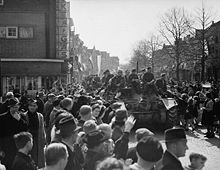 Canadian troops of the Stormont, Dundas and Glengarry Highlanders welcomed by liberated crowds in Leeuwarden, Netherlands, 16 April 1945.
Canadian troops of the Stormont, Dundas and Glengarry Highlanders welcomed by liberated crowds in Leeuwarden, Netherlands, 16 April 1945.
The responsibility for military command remained with the British Crown-in-Council, with a commander-in-chief for North America stationed at Halifax until the final withdrawal of British Army and Royal Navy units from that city in 1906. Thereafter, the Royal Canadian Navy was formed, and, with the advent of military aviation, the Royal Canadian Air Force. These forces were organised under the Department of Militia and Defence, and split into the Permanent and Non-Permanent Active Militias — frequently shortened to simply The Militia. By 1923, the department was merged into the Department of National Defence, but land forces in Canada were not referred to as the Canadian Army until November 1940.
The first overseas deployment of Canadian military forces occurred during the Second Boer War, when several units were raised to serve under British command. Similarly, when the United Kingdom entered into conflict with Germany in the First World War, Canadian troops were called to participate in European theatres. The Canadian Crown-in-Council then decided to send its forces into the Second World War, as well as the Korean War.
Since 1947, Canadian military units have participated in more than 200 operations worldwide, and completed 72 international operations. Canadian soldiers, sailors, and aviators came to be considered world-class professionals through conspicuous service during these conflicts and the country's integral participation in NATO during the Cold War, First Gulf War, Kosovo War, and in United Nations Peacekeeping operations, such as the Suez Crisis, Golan Heights, Cyprus, Croatia, Bosnia, Afghanistan, and Libya.
Battles which are particularly notable to the Canadian military include the Battle of Vimy Ridge, the Dieppe Raid, the Battle of Ortona, the Battle of Passchendaele, the Normandy Landings, the Battle for Caen, the Battle of the Scheldt, the Battle of Britain, the Battle of the Atlantic, the strategic bombing of German cities, and more recently the Battle of Medak Pocket.
At the end of the Second World War, Canada possessed the third-largest navy and fourth-largest air force in the world, as well as the largest volunteer army ever fielded. Conscription for overseas service was introduced only near the end of the war, and only 2,400 conscripts actually made it into battle.
Unification and beyond
See also: Unification of the Canadian ForcesThe current iteration of the Canadian Forces dates from 1 February 1968,[13] when the Royal Canadian Navy, Canadian Army, and Royal Canadian Air Force were merged into a unified structure and superseded by elemental commands. Its roots, however, lie in colonial militia groups that served alongside garrisons of the French and British armies and navies; a structure that remained in place until the early 20th century. Thereafter, a distinctly Canadian army and navy was established, followed by an air force, that, because of the constitutional arrangements at the time, remained effectively under the control of the British government until Canada gained legislative independence from the United Kingdom in 1931, partly due to the performance and sacrifice of the Canadian Corps in the First World War.[14][15]
The Canadian forces were afterwards heavily involved in the Second World War (which, as with the previous world war, involved conscription) and Korean War, and, from the 1950s on, actively worked with her NATO allies to counter the threats of the Cold War. Land Forces during this period also deployed in support of peacekeeping operations within United Nations sanctioned conflicts. The nature of the Canadian Forces has continued to evolve. They are currently engaged in Afghanistan, under the NATO-led United Nations International Security Assistance Force (ISAF), at the request of the Government of Afghanistan.
The forces are today funded by approximately $21.8 billion annually[4] ranked 13th, and are presently ranked 74th in size compared to the world's other armed forces by number of total personnel, and 58th in terms of active personnel, standing at a strength of roughly 67,000, plus 24,000 reservists and 19,000 supplementary reserves, bringing the reserve force to approximately 43,000.[16] The number of primary reserves is expected to go up to 30,000 by 2012, and the number of active to at least 70,000. If this happens the total strength would be around 120,000.[17] These individuals serve on numerous CF bases located in all regions of the country, and are governed by the Queen's Regulations and Orders and the National Defence Act.
The Conservative Cabinet appointed in 2006 made efforts through the Canada First Defence Strategy to purchase new equipment and training, as well as the re-establishment of an airborne land force, now called the Canadian Special Operations Regiment. More funds were also put towards recruitment, which had been dwindling throughout the 1980s and '90s, possibly because the Canadian populace had come to perceive the CF as peacekeepers rather than as soldiers, as shown in a 2008 survey conducted for the Department of National Defence. The poll found that nearly two thirds of Canadians agreed with the country's participation in the invasion of Afghanistan, and that the military should be stronger, but also that the purpose of the forces should be different, such as more focused on responding to natural disasters.[18] The current CDS, Walter Natynczyk, said later that year that while recruiting has become more successful, the CF was facing a problem with its rate of loss of existing members, which increased between 2006 and 2008 from 6% to 9.2% annually.[19]
Since 2006, the Government has initiated a major re-equipment effort to rebuild the Forces after the serious defence cuts of the 1990s. This program has already involved the acquisition of specific equipment (main battle tanks, artillery, unmanned air vehicles and other systems) to support the mission in Afghanistan. It has also encompassed initiatives to renew certain so-called "core capabilities" (such as the air force's medium range transport aircraft fleet – the C-130 Hercules – and the army's truck and armoured vehicle fleets). In addition, new capabilities (such as C-17 Globemaster III strategic transport aircraft and CH-47 Chinook heavy-lift helicopters) have also been acquired for the Forces. The program of capability renewal is ongoing and over the next twenty years aims to:
- Increase the number of military personnel to 70,000 Regular Forces and 30,000 primary Reserve Forces;
- Replace the Navy's current support ships with at least 2 new Joint Support Ships (with an option on a third);
- Build 15 warships to replace existing destroyers and frigates;
- Acquire new arctic/offshore patrol vessels;
- Replace the current maritime patrol aircraft with 10 to 12 new patrol aircraft;
- Acquire 65 F-35 Lightning II Joint Strike Fighters beginning in 2016-17 to replace the current fleet of CF-18 fighters;[20]
- Strengthen readiness and operational capabilities; and,
- Improve and modernize defence infrastructure.[10]
CH-147 ChinookRCAF CC-177 Globemaster on approach to CFB TrentonCurrent Structure
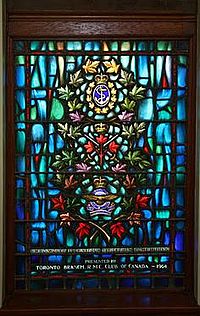 Memorial Stained Glass, Yeo Hall, Royal Military College of Canada (1964) with badges of the Royal Canadian Navy; Canadian Army and Royal Canadian Air Force
Memorial Stained Glass, Yeo Hall, Royal Military College of Canada (1964) with badges of the Royal Canadian Navy; Canadian Army and Royal Canadian Air Force
Per the Canadian constitution, command-in-chief of the Canadian Forces is vested in the country's sovereign,[7] who, since 1904, has allowed his or her viceroy, the governor general, to exercise the duties ascribed to the post of Commander-in-Chief and to hold the associated title since 1905.[8] All troop deployment and disposition orders, including declarations of war, fall within the Royal Prerogative and are issued as Orders in Council, which must be signed by either the monarch or governor general. Under the Westminster system's parliamentary customs and practices, however, the monarch and viceroy must generally follow the advice of his or her ministers in Cabinet, including the prime minister and Minister of National Defence.
The forces' 67,000 personnel are divided into a hierarchy of numerous ranks of commissioned and non-commissioned officers, and other non-commissioned positions. The governor general appoints, on the advice of the prime minister, a Chief of the Defence Staff (CDS) as the highest ranking commissioned officer in the forces and who, as head of the Armed Forces Council, commands the CF from the Department of National Defence Headquarters (NDHQ) in Ottawa, Ontario. On the Armed Forces Council sit the heads of the Royal Canadian Navy, Canadian Army, and Royal Canadian Air Force, who collectively oversee the operational commands of the Canadian Forces – the Canada Command, the Expeditionary Force Command, the Special Operations Forces Command, and the Operational Support Command. The sovereign and most other members of the Canadian Royal Family also act as colonels-in-chief, honorary air commodores, air commodores-in-chief, admirals, and captains-general of Canadian Forces regiments, though these positions are ceremonial.
Canada's forces operate out of 27 branch-specific Canadian Forces bases (CFB) across the country, as well as six shared bases, including the NDHQ; this number has been gradually reduced since the 1970s with bases either being closed or merged in the interest of efficiency. Officer cadets are educated and trained at two CF collegiate institutions, the Royal Military College of Canada and the Royal Military College Saint-Jean. Naval Cadets undergo basic training and ship handling training at the Naval Officers Training Centre at CFB Esquimalt near Victoria, B.C. Officers may also be commissioned on enrollment with a degree from a civilian university. In some cases, officers may also be commissioned from the senior non-commissioned ranks. Basic military training for non-commissioned members is provided at a variety of locations.
The Royal Canadian Navy (RCN), is headed by the Chief of the Maritime Staff, the RCN includes 33 warships and submarines deployed in two fleets: the Maritime Forces Pacific (MARPAC) at Her Majesty's Canadian Dockyard Esquimalt on the west coast, and the Maritime Forces Atlantic (MARLANT) at Her Majesty's Canadian Dockyard in Halifax on the east coast, as well as one formation: the Naval Reserve Headquarters (NAVRESHQ) at Quebec City, Quebec. The fleet is augmented by various aircraft and supply vessels.
The RCN participates in NATO exercises, and ships are deployed all over the world in support of the Canadian military as well as in conjunction with multinational deployments, including the current Operation APOLLO.
Canadian Army
Main article: Canadian ArmyThe Canadian Army (CA) (in French: Armée Canadienne), previously known as the Land Force Command,.[21] Headed by the Chief of the Land Staff, the Army is administered through four geographically determined formations, or areas: the Land Force Atlantic Area (LFAA), headquartered at CFB Halifax in Halifax, Nova Scotia; the Land Force Quebec Area (LFQA), headquartered in Montreal, Quebec; the Land Force Central Area (LFCA), located at Denison Armoury in Toronto, Ontario; and the Land Force Western Area (LFWA), headquartered in Edmonton, Alberta.
Currently, the Regular Force component of the Army consists of three field-ready brigade groups: 1 Canadian Mechanized Brigade Group, at CFB Edmonton and CFB Shilo; 2 Canadian Mechanized Brigade Group, at CFB Petawawa and CFB Gagetown; and 5 Canadian Mechanized Brigade Group, at CFB Valcartier and Quebec City. Each contains one regiment each of artillery, armour, and combat engineers, three battalions of infantry (all scaled in the British fashion), one for logistics, a squadron for headquarters/signals, and several minor organisations. A tactical helicopter squadron and a field ambulance are co-located with each brigade, but do not form part of the brigade's command structure.
Each land force area has, in addition to the Regular Force troops, reserve forces organized into a total of 10 reserve brigade groups. LFAA and LFQA each have two reserve brigade groups, while LFCA and LFWA have three apiece. Major training establishments and non-brigaded troops exist at CFB Gagetown, ASU Saint-Jean (now attached to CFB Montreal), and CFB Wainwright, which is home to the Canadian Manoeuvre Training Centre and provides state-of-the-art force-on-force training in preparation for overseas deployments.
Royal Canadian Air Force
The Royal Canadian Air Force (RCAF) is headed by the Chief of the Air Staff, based in Ottawa. The Commander of 1 Canadian Air Division and Canadian NORAD Region, based in Winnipeg, is responsible for the operational command and control of Air Force activities throughout Canada and worldwide. 1 Canadian Air Division operations are carried out through eleven Wings located across Canada. The Commander of 2 Canadian Air Division is responsible for training and support functions. 2 Canadian Air Division operations are carried out at two Wings. Wings represent the grouping of various squadrons, both operational and support, under a single tactical commander reporting to the operational commander and vary in size from several hundred personnel to several thousand.
Major air bases are located in British Columbia, Alberta, Saskatchewan, Manitoba, Ontario, Quebec, Nova Scotia, and Newfoundland and Labrador, while administrative and command-control facilities are located in Winnipeg and North Bay. A Canadian component of the NATO Airborne Early Warning Force is also based at NATO Air Base Geilenkirchen near Geilenkirchen, Germany.
The RCAF and Joint Task Force (North) (JTFN) also maintain at various points throughout Canada's northern region a chain of forward operating locations, each capable of supporting fighter operations. Elements of CF-18 squadrons periodically deploy to these airports for short training exercises or Arctic sovereignty patrols.
Canada Command
The Canada Command (CANCOM) is an operational element created on 31 January 2006, to improve response time to domestic terrorism and natural disasters, and is commanded by a commissioned officer who reports directly to the CDS. CANCOM is responsible for the management of RCN, Army, and RCAF assets assigned to it to ensure national security, both in emergency and routine situations, and is analogous to and works closely with the United States Northern Command, as well as the United States Department of Homeland Security. The command directs operations through six regional joint task forces, with Joint Task Force North responsible for activities previously carried out by Canadian Forces North Area.
Expeditionary Force Command
Canadian Expeditionary Force Command (French: Commandement de la Force expéditionnaire du Canada) is an operational element of the Canadian Forces for operations outside of Canada. Under the CF structure, Canadian Expeditionary Forces Command (CEFCOM) is the unified command that is responsible for all Canadian Forces (CF) international operations, with the exception of operations conducted solely by Canadian Special Operations Forces Command elements.[22]
Special Operations Forces Command
The Canadian Special Operations Forces Command (CANSOFCOM) is a unit capable of operating as an independent formation, but is primarily focused on generating Special Operations Forces (SOF) elements to support CANCOM and CEFCOM, and includes Joint Task Force 2 (JTF2) based at Dwyer Hill Training Center, the Canadian Special Operations Regiment (CSOR) and the 427 Special Operations Aviation Squadron (SOAS) at CFB Petawawa, as well as the Canadian Joint Incident Response Unit (CJIRU) at CFB Trenton (and CFB Kingston).
Operational Support Command
Main article: Canadian Operational Support CommandThe Canadian Operational Support Command is responsible for handling many of the support elements of the Canadian Forces such as the military police, health services and logistics.
Information Management Group
Among other things, the Information Management Group is responsible for the conduct of electronic warfare and the protection of the Forces communications and computer networks. Within the group, this operational role is fulfilled by the Canadian Forces Information Operations Group, headquartered at CFS Leitrim in Ottawa, which operates the following units: the Canadian Forces Information Operations Group Headquarters (CFIOGHQ), the Canadian Forces Electronic Warfare Centre (CFEWC), the Canadian Forces Network Operation Centre (CFNOC), the Canadian Forces Signals Intelligence Operations Centre (CFSOC), the Canadian Forces Station (CFS) Leitrim, and the 764 Communications Squadron. In June 2011 the Canadian Forces Chief of Force Development announced the establishment of a new organization headed by a Brigadier General to deal with cyber warfare.[23]
Canadian Forces Reserve Force
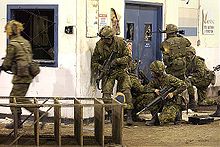 Reserve infantrymen train in urban operations, c. 2004. Reserve training focuses on real world situations and the needs of the Regular Force, who rely on the reserves for augmentation on operational deployments.
Reserve infantrymen train in urban operations, c. 2004. Reserve training focuses on real world situations and the needs of the Regular Force, who rely on the reserves for augmentation on operational deployments.
The Canadian Forces have a total reserve force of approximately 50,000 primary and supplementary that can be called upon in times of national emergency or threat.
Primary Reserve
Approximately 26,000 citizen soldiers, sailors, and airmen and women,[16] trained to the level of and interchangeable with their Regular Force counterparts, and posted to CF operations or duties on a casual or ongoing basis, make up the Canadian Forces Primary Reserve. This group is represented, though not commanded, at NDHQ by the Chief of Reserves and Cadets, who is usually a major general or rear admiral, and is divided into four components that are each operationally and administratively responsible to its corresponding environmental command in the Regular Force – the Naval Reserve (NAVRES), Land Force Reserve (LFR), and Air Reserve (AIRRES) – in addition to one force that does not fall under an environmental command, the Health Services Reserve.
Cadet Organizations Administration and Training Service
The Cadet Organizations Administration and Training Service (COATS)[24] consists of officers and non-commissioned members who conduct training, safety, supervision and administration of nearly 60,000 cadets aged 12 to 18 years in the Canadian Cadet Movement. The majority of members in COATS are officers of the Cadet Instructors Cadre branch of the CF. Members of the Reserve Force Sub-Component COATS who are not employed part time (Class A) or full time (Class B) may be held on the COATS "Inactive List" in anticipation of employment in the same manner as other reservists are held as members of the Supplementary Reserve.
Canadian Rangers
The Canadian Rangers, who provide surveillance and patrol services in Canada's arctic and other remote areas, are an essential reserve force component used for Canada's exercise of sovereignty over its northern territory.
Uniforms
A sergeant of The British Columbia Regiment (Duke of Connaught's Own) wearing the ceremonial dress of the regiment.
Although the Canadian Forces are a single service, there are three similar but distinctive environmental uniforms (DEUs): navy blue (which looks black) for the navy, rifle green for the army, and light blue for the air force. CF members in operational occupations generally wear the DEU to which their occupation "belongs." CF members in non-operational occupations (the "purple" trades) are allocated a uniform according to the "distribution" of their branch within the CF, association of the branch with one of the former services, and the individual's initial preference (once a DEU is assigned, it is difficult to change, without remustering). Therefore, on any given day, in any given CF unit, all three coloured uniforms may be seen.
The uniforms of the CF are sub-divided into five orders of dress:[25]
- Ceremonial dress, including regimental full dress, patrol dress, naval "high-collar" whites, and service dress uniforms with ceremonial accoutrements such as swords, white web belts, gloves, etc.;
- Mess dress, which ranges from full mess kit with mess jacket, cummerbund, or waistcoat, etc., to service dress with bow tie;
- Service dress, also called a walking-out or duty uniform, is the military equivalent of the business suit, with an optional white summer uniform for naval CF members;
- Operational dress, an originally specialized uniform for wear in an operational environment, now for everyday wear on base or in garrison; and
- Occupational dress, which is specialized uniform articles for particular occupations (e.g., medical/ dental).
Only service dress is suitable for CF members to wear on any occasion, barring "dirty work" or combat. With gloves, swords, and medals (No. 1 or 1A), it is suitable for ceremonial occasions and "dressed down" (No. 3 or lower), it is suitable for daily wear. Generally, after the elimination of base dress (although still defined for the Air Force uniform), operational dress is now the daily uniform worn by most members of the CF, unless service dress is prescribed (such as at the NDHQ, on parades, at public events, etc.). Approved parkas are authorized for winter wear in cold climates and a light casual jacket is also authorized for cooler days. The navy, most army, and some other units have, for very specific occasions, a ceremonial/regimental full dress, such as the naval "high-collar" white uniform, kilted Highland, Scottish, and Irish regiments, and the scarlet uniforms of the Royal Military Colleges.[26]
Authorized headdress for the Canadian Forces are the service cap (male and female versions), beret, wedge cap, ballcap, Yukon cap, and tuque (toque). Each is coloured according to the distinctive uniform worn: navy (white or navy blue), army (rifle green or "regimental" colour), air force (light blue). Adherents of the Sikh faith may wear uniform turbans (dastar) (or patka, when operational) and Muslim women may wear uniform tucked hijabs under their authorized headdress. Jews may wear yarmulke under their authorized headdress and when bareheaded. The beret is probably the most widely worn headgear and is worn with almost all orders of dress (with the exception of the more formal orders of Navy and Air Force dress), and the colour of which is determined by the wearer's environment, branch, or mission. Naval personnel, however, seldom wear berets, preferring either service cap or authorized ballcaps (shipboard operational dress), which only the Navy wear. Air Force personnel, particularly officers, prefer the wedge cap to any other form of headdress. There is no naval variant of the wedge cap. The Yukon cap and tuque are worn only with winter dress, although clearance and combat divers may wear tuques year-round as a watch cap. Soldiers in Highland, Scottish, and Irish regiments generally wear alternative headdress, including the glengarry, balmoral, tam o'shanter, and caubeen instead of the beret. The officer cadets of both Royal Military Colleges wear gold-braided "pillbox" (cavalry) caps with their ceremonial dress and have a unique fur "Astrakhan" for winter wear. The Canadian Army wears the CG634 helmet.
Military expenditures
The Constitution of Canada gives the federal government exclusive responsibility for national defence, and expenditures are thus outlined in the federal budget. For the 2008-2009 fiscal year, the amount allocated for defence spending was CAD$18.9 billion.[27] This regular funding was augmented in 2005 with an additional CAD$12.5 billion over five years, as well as a commitment to increasing regular force troop levels by 5,000 persons, and the primary reserve by 3,000 over the same period.[28] In 2006, a further CAD$5.3 billion over five years was provided to allow for 13,000 more regular force members, and 10,000 more primary reserve personnel, as well as CAD$17.1 billion for the purchase of new trucks for the Canadian Army, transport aircraft and helicopters for the Royal Canadian Air Force, and joint support ships for the Royal Canadian Navy.[29]
See also
- Authorized marches of the Canadian Forces
- Canada First Defence Strategy
- Canadian Cadet Movement
- Canadian Forces order of precedence
- Canadian Forces Radio and Television
- Code of Service Discipline
- Future Canadian Forces projects
- List of Canadian military operations
- List of infantry weapons and equipment of the Canadian military
- Defence diplomacy
- North Warning System
- Communications Security Establishment Canada
Notes
- ^ Persons 17 years of age, with parental permission, can join the Canadian Forces.
References
- ^ Department of National Defence. "National Defence and the Canadian Forces > Chief of the Defence Staff". Queen's Printer for Canada. http://www.cds.forces.gc.ca/index-eng.asp. Retrieved 16 October 2008.
- ^ a b "Recruiting and Retention in the Canadian Forces > Canada > Military". Department of National Defence. 31 december 2009. http://www.forces.gc.ca/site/news-nouvelles/news-nouvelles-eng.asp?id=3792. Retrieved 31 december 2009.
- ^ "The World Factbook > Canada > Military". Central Intelligence Agency. 18 December 2008. https://www.cia.gov/library/publications/the-world-factbook/geos/ca.html#Military. Retrieved 19 January 2009.
- ^ a b Treasury Board Secretariat. "Estimates > Reports on Plans and Priorities > 2010-2011". Queen's Printer for Canada. http://www.tbs-sct.gc.ca/rpp/2010-2011/inst/dnd/dnd01-eng.asp#sec1g_e. Retrieved 2009-11-13.
- ^ Canadian Defence Review Canada's 2011 Top 50 Defence Companies. Retrieved on: 2011-08-28
- ^ a b Elizabeth II (1985). National Defence Act. II.14. Ottawa: Queen's Printer for Canada. http://www.canlii.org/en/ca/laws/stat/rsc-1985-c-n-5/latest/rsc-1985-c-n-5.html. Retrieved 20 January 2009.
- ^ a b Victoria (29 March 1867). Constitution Act, 1867. III.15. Westminster: Queen's Printer. http://www.solon.org/Constitutions/Canada/English/ca_1867.html. Retrieved 15 January 2009.
- ^ a b "Governor General of Canada > Commander-in-Chief". Rideau Hall. http://gg.ca/gg/rr/cc/index_e.asp. Retrieved 15 January 2009.
- ^ Department of National Defence "Canada First Defence Strategy"
- ^ a b Department of National Defence http://www.forces.gc.ca/site/focus/first-premier/defstra/summary-sommaire-eng.asp
- ^ "Canadian Defence Attaché Network". Outcan.forces.gc.ca. 2010-07-22. http://www.outcan.forces.gc.ca/sites/page-eng.asp?page=8890. Retrieved 2011-03-23.
- ^ For example, through the Military Training and Cooperation Program and its ancillary activities http://www.forces.gc.ca/admpol/mtcp-eng.html
- ^ Gilmour, Sarah (17 May). "Navy celebrates 96 years". The Maple Leaf 9: 10. http://www.forces.gc.ca/site/community/MapleLeaf/vol_9/vol9_19/919_10.pdf.
- ^ Nersessian, Mary (9 April 2007). "Vimy battle marks birth of Canadian nationalism". CTV. http://www.ctv.ca/servlet/ArticleNews/story/CTVNews/20070402/vimy_90years_070402. Retrieved 20 January 2009.
- ^ Cook, Tim (2008). Shock troops: Canadians fighting the Great War, 1917-1918. Toronto: Viking. ISBN 0670067350.
- ^ a b Department of National Defence (19 December 2008). "National Defence and the Canadian Forces > About DND/CF". Queen's Printer for Canada. http://www.forces.gc.ca/site/news-nouvelles/view-news-afficher-nouvelles-eng.asp?id=2865. Retrieved 2 January 2009.
- ^ http://www.casr.ca/doc-canada-first-defence-strategy-1.htm
- ^ The Canadian Press (5 September 2005). "Canadians still view troops as peacekeepers: DND poll". CTV. http://www.ctv.ca/servlet/ArticleNews/story/CTVNews/20080905/dnd_poll_080905/20080905?hub=TopStories. Retrieved 5 September 2008.
- ^ The Canadian Press (21 November 2008). "Military as message for job seekers: we want you". CTV. http://www.ctv.ca/servlet/ArticleNews/story/CTVNews/20081121/forces_canada_081121/20081121?hub=Canada. Retrieved 22 November 2008.
- ^ 'Canada to spend $9B on F-35 fighter jets." CBC, 16 July 2010. Retrieved: 16 July 2010.
- ^ Department of National Defence. "Join the Canadian Army". Queen's Printer for Canada. http://www.army.forces.gc.ca/lfwa/join.asp. Retrieved 21 January 2009.
- ^ "Canadian Expeditionary Force Command". National Defence and the Canadian Forces. http://www.cefcom.forces.gc.ca/pa-ap/about-notre/index-eng.asp. Retrieved 20100-20-03.
- ^ The Maple Leaf, 22 June 2011, Vol. 14, No. 22, p.3
- ^ "Administrative Order: Implementation of Cadet Organizations Administration and Training Service", NDHQ 1085-30 (D Cdts 6) dated 2 July 2009.
- ^ Canada – National Defence: "A-AD-265-000/AG-001 CANADIAN FORCES DRESS INSTRUCTIONS"
- ^ Government of Canada. "Canadian Military Heritage > Officer cadet, Royal Military College of Canada, 1954". Queen's Printer for Canada. http://www.cmhg.gc.ca/cmh/image-504-eng.asp?page_id=548. Retrieved 23 January 2009.
- ^ Treasury Board of Canada Secretariat. "Departmental Planned Spending and Full-Time Equivalents". Queen's Printer for Canada. http://www.tbs-sct.gc.ca/rpp/2008-2009/inst/dnd/images/sec1f-table1-lg-eng.jpg. Retrieved 2 February 2009.
- ^ Department of Finance (2005). The Budget Speech 2005. Canada in the World. Ottawa: Her Majesty the Queen in Right of Canada. p. 20. http://www.fin.gc.ca/budget05/pdf/speeche.pdf. Retrieved 2 February 2009.
- ^ Department of National Defence. ""Canada First" National Defence Procurement". Queen's Printer for Canada. http://www.forces.gc.ca/site/focus/first-premier/index-eng.asp. Retrieved 2 February 2009.
Further reading
Main article: Bibliography of Canadian military history- Morton, Desmond (1999). A military history of Canada (4th ed.). Toronto: McClelland and Stewart. ISBN 0771065140. http://books.google.ca/books?id=ui8ecMckv08C&lpg=PP1&dq=A%20military%20history%20of%20Canada&pg=PP1#v=onepage&q&f=true.
- Granatstein, J. L (2004). Canada's army: waging war and keeping the peace. University of Toronto Press. ISBN 0802086969. http://books.google.ca/books?id=jqxyhNcha3sC&lpg=PP1&dq=Army%20%20of%20Canada&pg=PP1#v=onepage&q&f=true
- Zuehlke, Mark (2006). Canadian Military Atlas: Four Centuries of Conflict from New France to Kosovo. Douglas & McIntyre. ISBN 9781553652090. http://books.google.ca/books?id=KyNlm8SuplEC&lpg=PP1&dq=canadian%20military%20atlas&pg=PP1#v=onepage&q&f=false
- Faces of War at Library and Archives Canada
External links
- Official website of the Royal Canadian Navy
- Official website of the Canadian Army
- Official website of the Royal Canadian Air Force
- Duty & Valour, Canada's military history encyclopedia
- Combat Camera – Official CF photo website (Note: image licencing is not compatible with Wikipedia licences)
Categories:- Canadian Forces
- Department of National Defence (Canada)
- Military of Canada
- Uniformed services of Canada
- Canadian Newsmakers of the Year
Wikimedia Foundation. 2010.

